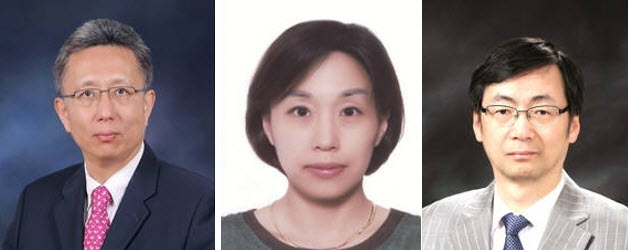
(From left) Professors JEONG Do Un, LEE Yu Jin, and PARK Kwang Suk
Previous experiments to predict the quality of sleep had to be done while the subject was asleep throughout the night. College of Medicine Professors Park Kwang Suk, Jeong Do Un, and Lee Yu Jin discovered a method in which the quality of sleep could be predicted by examining the subject for only five minutes before they fall asleep.
The research team hypothesized that the autonomic nervous system activity immediately before sleep closely correlates with sleep efficiency.
The autonomic nervous system is classified into the sympathetic and parasympathetic nervous systems. The sympathetic nervous system governs activity in the body while the parasympathetic nervous system is related to rest. During sleep, the parasympathetic nervous system becomes more active, reducing the heart rate and relaxing blood vessels.
In contrast, if the sympathetic nervous system is active just before sleep, there is a high possibility that one will be unable to have a deep sleep. The team therefore concluded that sleep quality can be predicted by identifying the activity of the autonomic nervous system.
To test the hypothesis, 60 participants lay for five minutes on a bed with a paper-thin film-type piezoelectric sensor -- a device that measures changes in pressure, acceleration, temperature, strain, and force by converting energy into electrical charge -- installed on the mattress. The team predicted the participants’ quality of sleep by measuring their cardiorespiratory signals such as the heartbeat and respiration with the piezoelectric sensor. Cardiorespiratory signals indicate changes in the autonomic nervous system.
After the five-minute examination, the participants underwent traditional polysomnography, the current standard for sleep evaluation, in order to compare the results. Results showed only a 2% margin of error between the new, five-minute evaluation and the more cumbersome polysomnographic method.
Polysomnography simultaneously measures brainwave activity, blood oxygen levels, respiration, and heart rate, allowing for a comprehensive test for various sleep problems. The drawbacks however, are that many pieces of equipment have to be attached to the participant, who must be monitored for the course of an entire night’s sleep.
The new method, by contrast, requires little in the way of equipment and only takes a short time. Furthermore, the participant does not need to be asleep for the experiment.
Professor Park said that this method will be widely used to measure not only the quality of sleep, but also one’s general physical health. The experiment’s findings were published in the online scientific journal, Chronobiology International.
Written by Hye Bin Lee, SNU English Editor, hahahybes@snu.ac.kr
Reviewed by Professor Travis Smith, Department of Asian Languages and Civilizations, tlsmith@snu.ac.kr

